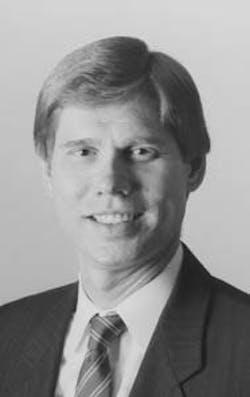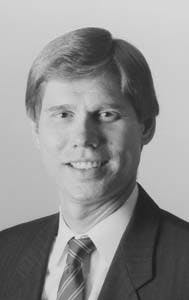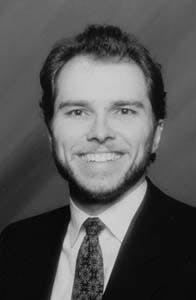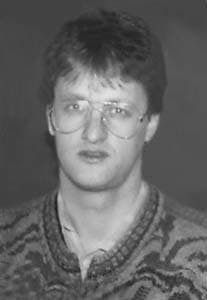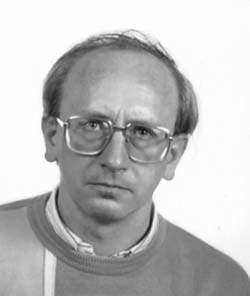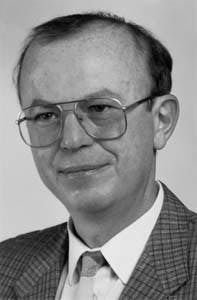AUSTRIAN REFINER BENEFITS FROM ADVANCED CONTROL
Lynn A. Richard, Mark Spencer
Setpoint Inc.
HoustonRudolf Schuster, Dieter M. Tuppinger, Wilhelm F. Wilmsen
OMV-AG Energy
Schwechat, Austria
OMV-AG Energy implemented advanced process controls on 27 units at its refinery in Schwechat, Austria. A variety of controls were implemented on the butadiene and methyl tertiary butyl ether (MTBE) units in January 1993.
After more than 1 year of operation, the butadiene/MTBE project has shown a number of benefits, including reduced energy consumption and increased capacity in both units.
PROCESS DESCRIPTION
OMV's Schwechat refinery is a complex facility with 10 million metric tons/year (210,000 b/d) of crude oil capacity (Fig. 1). (143605 bytes) The butadiene and MTBE units increase the value of the C4 stream.
The butadiene unit recovers 1,3-butadiene from a mixed-C4 feed stream using technology licensed by BASF AG, Ludwigshafen, Germany. First, the feed is separated into crude butadiene, raffinate, and acetylene streams in the extractive distillation section. The crude butadiene is then further purified in two distillation columns.
The final product purity specification is 99.7 vol % 1,3-butadiene. A diagram of the butadiene unit is shown in Fig. 2 (57164 bytes).
The MTBE unit converts methanol and isobutene to MTBE using technology licensed from Snamprogetti S.p.A. The unit gets its C4 feed from the butadiene extraction and fluid catalytic cracking (FCC) units.
The C4 feed and methanol react in two jacketed, multitubular reactors. The MTBE product is recovered at 99 vol % purity as the MTBE column bottoms.
The excess methanol and remaining C4 compounds are washed with water in the extractor. The methanol then is separated from the water in the recovery column.
A diagram of the MTBE unit is shown in Fig. 3 (57667 bytes).
ADVANCED CONTROL
The advanced controls were implemented in a DEC VAX using Setpoint Inc.'s real-time data base system. The system allows user-programmed control algorithms to be tightly integrated with its standard control algorithms. These user process controllers (UPCs) are configured with fill-in-the-blank forms and scheduled exactly as a standard controller.
This project made heavy use of a library of advanced control algorithms implemented as UPCS. Three were used extensively for the butadiene and MTBE units:
- Constraint controller
- Nonlinear proportional integral (PI) controller
- Simple model predictive controller (SMPC).
The constraint controller monitors multiple process constraints to determine if its setpoint should be implemented, or if action to control at a limit is needed. It can be used to maximize or minimize a variable or override the output of another controller.
The nonlinear PI controller provides more aggressive control as the deviation from setpoint increases. It is designed to control "integrating" processes. (Level is an example of an integrating process. When the process flow rate is increased, the level will continue to increase until the flow is changed back to the equilibrium rate.)
The purpose of the nonlinear PI controller is to minimize movement of the manipulated variable.
SMPC
The simple model predictive controller was used heavily for the butadiene and MTBE units because of its ability to handle long dead times and intermittent analyzer signals. A model of the response of the controlled variable to changes in the manipulated variable is used.
The controller predicts the responses from past moves and calculates the move required to return to setpoint. The model includes dead time and can be first or second-order Laplace or discrete Z-transform format.
The term "simple" in the controller name is used to differentiate it from another related control term, .model predictive control," or MPC. The SMPC algorithm, by comparison, is single-variable.
MPC generally is used to refer to multivariable controllers with general-order models. The simplification greatly reduces the computational load of the algorithm.
The controller has the ability to use an intermittent signal, such as is found with gas chromatograph analyzers. The model's predictions are updated only when a new analysis is available. The optional time-out period may be used to "fail" the controller when the analyzer is unavailable.
The controller's main tuning parameter is the closed-loop response time. A shorter response time decreases the deviations from setpoint at the expense of increased movement of the manipulated variable. A longer response time will increase the controller's tolerance to changes in the underlying process (i.e., the "robustness" to model mismatch).
- partial list of other controller features includes:
- Feed-forward compensation from several disturbance variables, or variables that will disturb process control
- Ability to control integrating processes
- High and low setpoint limits
- Output rate-of-change limits
- Wind-up status handling. (This term refers to passing information back "up' a series of controllers. In other words, if one controller in a cascade reaches a limit, this message must be transmitted to the controllers that are higher in the loop.)
CONTROL OBJECTIVES
There are four general objectives for the advanced control system:
- Increased unit capacity
- Stabilized operation
- Controlled product recovery
- Reduced energy consumption.
The constraint controller algorithm is used to increase unit capacity. The unit feed rate is maximized subject to process constraints and an operator-entered limit.
If a process constraint is active, the feed rate is set to the highest possible value that will not cause violations of the specifications. Both the butadiene and MTBE units use feed rate maximization strategies.
The nonlinear PI controller algorithm helps stabilize operation of the unit. Three strategies in the butadiene and MTBE units control level and minimize flow disturbances to the downstream process equipment.
The SMPC algorithm is used to control product recovery and energy consumption. By controlling product impurities and moving them closer to specifications, product recovery is maximized for a given amount of energy consumption.
Increasing the energy consumption will increase recovery if the process equipment is not limiting. The tradeoff is controlled with the setpoint, or set-points, of the product component concentration in the nonproduct streams.
The advanced strategies using the SMPC algorithm are detailed in the following sections.
BUTADIENE UNIT
In the butadiene unit, sixteen distributed control system (DCS) set-points are set by the advanced controls. Six strategies use the SMPC to control compositions measured with gas chromatograph analyzers:
- The cis-2-butene concentration in the crude butadiene is controlled by manipulating the after-washer distillate flow (Fig. 2). (57164 bytes) The feed-forward option of the SMPC algorithm is used to reduce the disturbances caused by changes in the butadiene feed rate. The disturbance variable is calculated from the feed rate of the main washer and its 1,3-butadiene concentration.
This strategy was the most difficult to commission because of the long process response time, highly nonlinear column behavior, and frequent disturbances. In manual operation mode, the operator had maintained the concentration mostly at zero, which decreased butadiene recovery.
After testing several systems, a "second-order plus dead time" model and a nonlinear response time were chosen for use with the SMPC. Tuning with a second-order model is less intuitive and more difficult than with a first-order model, and it requires an off-line simulation of the response of the controlled system. This step was not necessary with the other controllers using first-order models.
The controller's nonlinear response was implemented with custom code to make the controller more aggressive (reduce the response time) as the controller error increases. Also, the nonlinear response is more aggressive for high concentration values that tend to violate the product specification.
Fig. 4 (48096 bytes) compares the cis-2-butene concentration before and after advanced control. This control strategy has allowed an increase in the average cis-2-butene concentration of the crude butadiene, thereby increasing recovery of the final butadiene product.
- The 1,3-butadiene concentration of the raffinate is controlled by manipulating the ratio of n-methyl-pyrrolidone (NMP) to feed in the main washer. A feed-forward move is made for changes in the crude butadiene flow rate (the manipulated variable of the strategy described previously). This helps reduce interaction between the two strategies.
A constraint controller will act to prevent violations of the process limits for maximum NMP flow.
Fig. 5 (46320 bytes) compares the 1,3-butadiene concentration before and after advanced control. The control strategy allows the loss of 1,3-butadiene in the raffinate to be controlled and balanced against the increased energy required for its recovery.
- The C4 acetylene concentration in the offgas stream is controlled by manipulating the flow of dilution gas. The C4 acetylenes measured in the offgas are 1-butyne (ethylacetylene) and butenyne (vinylacetylene). Their total concentration must be kept below the explosion limit.
The dilution gas is required to replace in the offgas stream the water that is later removed by condensation, and to maintain safe concentrations at all locations in the system.
This strategy reduces the amount of dilution gas used while maintaining a safe concentration of C4 acetylenes.
- The 1,3-butadiene concentration in the C4 acetylene stream is controlled by manipulating its flow rate. The effective concentration before dilution is calculated for use as the controlled variable. A constraint controller acts to prevent violations of process limits related to the maximum acetylene flow rate.
This strategy allows the loss of 1,3-butadiene in the acetylene stream to be controlled and balanced against the increased energy required for recovery.
- The propyne (methlacetylene) concentration in the butadiene product is controlled by manipulating the propyne column reboiler steam-to-feed ratio. This strategy reduces the amount of energy used in the column while maintaining the product specification.
- The 1,2-butadiene concentration in the butadiene product is controlled by manipulating the reflux flow rate. A feed-forward move is made for changes in feed flow. Because the butadiene column feed rate is not measured, the propyne column feed rate is used as the disturbance variable.
Fig. 6 (45328 bytes) compares the 1,2-butadiene concentration before and after advanced control. This strategy reduces the amount of energy used in the column while maintaining the product specification. It also provides a small increase in product recovery.
MTBE UNIT
In the MTBE unit, the advanced controls set 12 DCS controller set-points. Four strategies use the SMPC to control the compositions measured using gas chromatograph analyzers:
- The methanol concentration in the effluent from the second reactor is controlled by manipulating the methanol-to-isobutene-feed ratio. The isobutene feed is calculated from the flow rate and measured concentration.
Because the reactor positions can be switched, the controller must read the correct effluent analyzer as the controlled variable. The operator enters the reactor positions via a "flag."
Fig. 7 (45229 bytes) compares the methanol concentration before and after advanced control. This strategy stabilizes the feed composition of the separation section.
- The MTBE concentration in the extractor raffinate is controlled by manipulating the setpoint of the MTBE-column overhead temperature. The temperature is pressure-compensated to prevent changes in pressure from disturbing the composition control.
Feed-forward moves are made from the column feed rate and reboiler steam flow. The final manipulated variable is the column reflux, compensated for subcooling.
Fig. 8 (45421 bytes) compares the MTBE concentration before and after advanced control. This strategy allows the loss of MTBE in the raffinate to be controlled and balanced against the increased energy required for recovery.
- The total C4 concentration in the MTBE product is controlled by manipulating a lower tray-temperature setpoint. A feed-forward move is made from the column feed rate.
The constraint controller acts to prevent violations of process limits. The final manipulated variable is the MTBE-column reboiler steam flow.
- The methanol concentration in the recovery-column bottoms is controlled by manipulating a lower tray-temperature setpoint. Feed-forward moves are made from the column feed rate and reflux flow. The final manipulated variable is the reboiler steam flow.
This strategy stabilizes the extractor operation by providing a constant methanol concentration in the extractor water.
BENEFITS
The advanced controls for the butadiene and MTBE units meet the product specifications with reduced operator load. Because butadiene and MTBE are commercial products, assuring a high and stable product quality is essential for OMV's ISO 9000 compliance.
Before advanced control, these two units required one control room operator. Now, one operator can monitor both units, plus a reformer and a hydrotreater.
The plant manager determines the desired tradeoff between product recovery and energy consumption by setting the advanced controller targets. Throughout each shift these operating objectives are consistently enforced by the advanced controls.
The measurable benefits from the advanced control project result from reduced energy consumption, increased product recovery, and maximized capacity.
The butadiene unit advanced control reduced medium-pressure steam consumption by 8% and low-pressure steam consumption by 32%. And solvent consumption has decreased by 10%. All of these reductions have been achieved at constant recovery.
Because of the current low price of butadiene, an increase in recovery, and therefore energy, - is not justified. OMV has achieved a capacity increase of 35%, depending on feed composition.
The MTBE unit has demonstrated a 6-9% reduction in energy consumption and a 5% increase in capacity.
ACKNOWLEDGMENT
The authors wish to thank the OMV refinery management for its support and permission to publish this article.
BIBLIOGRAPHY:
Richard, L., et al., "Successful Implementation of Advanced Control in a MHC-VGO Unit," Hydrocarbon Processing, scheduled for publication, March 1995.
Wilmsem, W.F. and Densman, B., "Computer Integrated Manufacturing (CIM) in a Petroleum Refinery," presented at the NPRA computer conference, Washington, D.C., 1992, published in Oil and Gas European Magazine, January 1993.
THE AUTHORS
Richard has been at Setpoint for 17 years. He has a BS degree from Iowa State University and an MS from Louisiana State University, both in chemical engineering. He is a member of American Institute of Chemical Engineers and the Instrument Society of America.
Tuppinger worked in the area of experimental physics for 6 years at Austria's Technical University and the University of Vienna. He holds a doctorate degree in physics, specializing in quantum mechanics and material science.
Copyright 1995 Oil & Gas Journal. All Rights Reserved.
